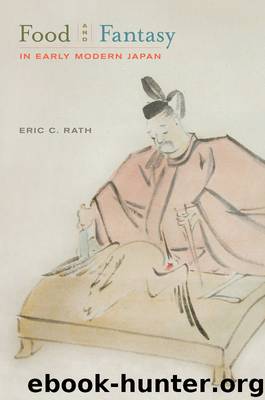Food and Fantasy in Early Modern Japan by Rath Eric

Author:Rath, Eric
Language: eng
Format: epub
ISBN: 9780520947658
Publisher: University of California Press
THE IDEAL OF COOKBOOKS
The evidence we have examined thus far points to a disparity between the contents of Edo-period culinary books and the daily diet and experience of the authors and readers of these works. We should not be surprised by this. Priscilla Parkhurst Ferguson reminds us that “cookbooks legislate rather than document.”36 In other words, cookbooks and other types of culinary writings provide directions for preparing and consuming foods under ideal circumstances. They begin with the assumption that all the ingredients are available and affordable, and that these can be easily assembled and correctly served. Cookbook authors offer a potential use for food, but this does not ensure that these guidelines have been or ever will be followed and the dishes themselves created or the banquets served and consumed. A historian of Japanese cookbooks, Shoko Higashiyotsuyanagi, confirms this view concerning cookbooks in the early modern period: “For most of the Edo period, cookbooks were intended for a male audience and were more voyeuristic than practical. They were not intended for home cooking; rather, they described the preparation of formal sumptuous banquets and served the purposes of hobby reading. All authors and editors were male, and in cases where the books did provide practical information, the target audiences clearly were male professional cooks and dilettantes.”37
Consequently, one of the tasks for historians of Japanese cuisine is to try to judge how much the contents of cookbooks reflected the actual cooking practices of the work’s authors and readers. Culinary historian Harada Nobuo, who has extensively studied Edo-period culinary books, has documented what he sees as a historical shift in Edo-period culinary books that occurred in the mid-eighteenth century, when writings began to favor amusement (asobi) over discussions of the technicalities of food preparation.38 Harada indicates that, by the 1750s, cooking methods had reached a plateau, and authors shifted to writing more imaginative works that could simply be read for pleasure.39 “They regale readers with entertaining reading on culinary subjects, but provide little or nothing of significance on technical aspects of food preparation.” By the end of the Edo period, Harada concludes, Japanese cuisine had grown “stagnant.”40
Harada finds playfulness to be characteristic of culinary books published after the mid-eighteenth century, but when we recall that many of the works published nearly a century earlier, such as Collection of Cooking Menus (1671) and Edo Cookery Collection (1674), contained menus and recipes that nearly all readers of these works could not legally create or consume, it becomes harder to draw a line between works offering a serious technical discussion of cooking and ones meant for amusement. In that light, readers in the Edo period may have recognized Harada’s distinction between “amusing” and “serious” culinary books only if they tried to create the recipes in either one. But cookbooks, especially those focusing on foods served in formal settings, may not have been written with that sole purpose in mind. It was not until the Meiji period that most cookbooks began to focus on domestic cooking, describing what people actually prepared and ate.
Download
This site does not store any files on its server. We only index and link to content provided by other sites. Please contact the content providers to delete copyright contents if any and email us, we'll remove relevant links or contents immediately.
| Africa | Americas |
| Arctic & Antarctica | Asia |
| Australia & Oceania | Europe |
| Middle East | Russia |
| United States | World |
| Ancient Civilizations | Military |
| Historical Study & Educational Resources |
The Sympathizer by Viet Thanh Nguyen(4099)
The Rape of Nanking by Iris Chang(4025)
World without end by Ken Follett(3348)
Ants Among Elephants by Sujatha Gidla(3282)
Blood and Sand by Alex Von Tunzelmann(3061)
Japanese Design by Patricia J. Graham(3006)
City of Djinns: a year in Delhi by William Dalrymple(2438)
Foreign Devils on the Silk Road: The Search for the Lost Treasures of Central Asia by Peter Hopkirk(2389)
Inglorious Empire by Shashi Tharoor(2349)
The Queen of Nothing by Holly Black(2326)
India's Ancient Past by R.S. Sharma(2307)
In Order to Live: A North Korean Girl's Journey to Freedom by Yeonmi Park(2305)
Tokyo by Rob Goss(2295)
India's biggest cover-up by Dhar Anuj(2251)
Tokyo Geek's Guide: Manga, Anime, Gaming, Cosplay, Toys, Idols & More - The Ultimate Guide to Japan's Otaku Culture by Simone Gianni(2245)
The Great Game: On Secret Service in High Asia by Peter Hopkirk(2231)
Goodbye Madame Butterfly(2165)
Batik by Rudolf Smend(2010)
Living Silence in Burma by Christina Fink(1988)
